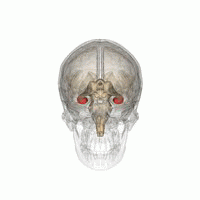
Photo from wikipedia
Hemoglobin (Hb) is the oxygen transport protein in erythrocytes. In blood, Hb is a tetramer consisting of two Hb-alpha (Hb-α) chains and two Hb-beta (Hb-β) chains. A number of studies… Click to show full abstract
Hemoglobin (Hb) is the oxygen transport protein in erythrocytes. In blood, Hb is a tetramer consisting of two Hb-alpha (Hb-α) chains and two Hb-beta (Hb-β) chains. A number of studies have also shown that Hb-α is also expressed in neurons in both the rodent and human brain. In the current study, we examined for age-related regulation of neuronal Hb-α and hypoxia in the hippocampus and cerebral cortex of intact male and female mice. In addition, to confirm the role and functions of neuronal Hb-α, we also utilized lentivirus CRISPR interference-based Hb-α knockdown (Hb-α CRISPRi KD) in the non-ischemic and ischemic mouse hippocampus and examined the effect on neuronal oxygenation, as well as induction of hypoxia-inducible factor-1α (HIF-1α) and its downstream pro-apoptotic factors, PUMA and NOXA, and on neuronal survival and neurodegeneration. The results of the study revealed an age-related decrease in neuronal Hb-α levels and correlated increase in hypoxia in the hippocampus and cortex of intact male and female mice. Sex differences were observed with males having higher neuronal Hb-α levels than females in all brain regions at all ages. In vivo Hb-α CRISPRi KD in the mouse hippocampus resulted in increased hypoxia and elevated levels of HIF-1α, PUMA and NOXA in the non-ischemic and ischemic mouse hippocampus, effects that were correlated with a significant decrease in neuronal survival and increased neurodegeneration. As a whole, these findings indicate that neuronal Hb-α decreases with age in mice and has an important role in regulating neuronal oxygenation and neuroprotection.
Journal Title: International Journal of Molecular Sciences
Year Published: 2022
Link to full text (if available)
Share on Social Media: Sign Up to like & get
recommendations!